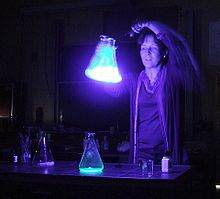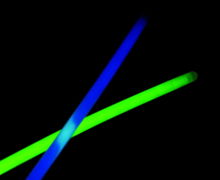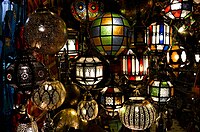Chemiluminescence

Chemiluminescence (also chemoluminescence) is the emission of light (
Physical description
As in many chemical reactions, chemiluminescence starts with the combining of two compounds, say A and B, to give a product C. Unlike most chemical reactions, the product C converts to a further product, which is produced in an electronically excited state often indicated with an asterisk:
- A + B → C
- C → D*
D* then emits a photon (hν), to give the ground state of D:[1] I
- D* → D + hν
In theory, one
For example, A could be
Chemiluminescence differs from

Liquid-phase reactions
Chemiluminescence was first observed with lophine (triphenylimidazole).[2] When in basic solution, this compound converts to the imidazolate, which reacts with oxygen to eventually give a dioxetane. Fragmentation of the dioxetane gives the excited state of an anionic diamide.[3]

Chemiluminescence in aqueous system is mainly caused by redox reactions.[4]

- oxidant,[6]produces chemiluminescence. The luminol reaction is
Gas-phase reactions

- One of the oldest known chemiluminescent reactions is that of elemental white phosphorus oxidizing in moist air, producing a green glow. This is a gas-phase reaction of phosphorus vapor, above the solid, with oxygen producing excited states of (PO)2 and HPO.[7]
- Another gas phase reaction is the basis of nitric oxide detection in commercial analytic instruments applied to environmental air-quality testing. Ozone (O3) is combined with nitric oxide (NO) to form nitrogen dioxide (NO2) in an activated state [◊]:
- The activated NO2[◊] luminesces broadband visible to infrared light as it reverts to a lower energy state. A photomultiplier and associated electronics counts the photons that are proportional to the amount of NO present. To determine the amount of nitrogen dioxide, NO2, in a sample (containing no NO) it must first be converted to nitric oxide, NO, by passing the sample through a converter before the above ozone activation reaction is applied. The ozone reaction produces a photon count proportional to NO that is proportional to NO2 before it was converted to NO. In the case of a mixed sample that contains both NO and NO2, the above reaction yields the amount of NO and NO2 combined in the air sample, assuming that the sample is passed through the converter. If the mixed sample is not passed through the converter, the ozone reaction produces activated NO2[◊] only in proportion to the NO in the sample. The NO2 in the sample is not activated by the ozone reaction. Though unactivated NO2 is present with the activated NO2[◊], photons are emitted only by the activated species that is proportional to original NO. Final step: Subtract NO from (NO + NO2) to yield NO2[8]
Infrared chemiluminescence
In chemical kinetics, infrared chemiluminiscence (IRCL) refers to the emission of infrared photons from vibrationally excited product molecules immediately after their formation. The intensities of infrared emission lines from vibrationally excited molecules are used to measure the populations of vibrational states of product molecules.[9][10]
The observation of IRCL was developed as a kinetic technique by John Polanyi, who used it to study the attractive or repulsive nature of the potential energy surface for gas-phase reactions. In general the IRCL is much more intense for reactions with an attractive surface, indicating that this type of surface leads to energy deposition in vibrational excitation. In contrast reactions with a repulsive potential energy surface lead to little IRCL, indicating that the energy is primarily deposited as translational energy.[11]
Enhanced chemiluminescence
Enhanced chemiluminescence (ECL) is a common technique for a variety of detection assays in biology. A
Applications
- Gas analysis: for determining small amounts of impurities or poisons in air. Other compounds can also be determined by this method (ozone, N-oxides, S-compounds). A typical example is NO determination with detection limits down to 1 ppb. Highly specialised chemiluminescence detectors have been used recently to determine concentrations as well as fluxes of NOx with detection limits as low as 5 ppt.[14][15][16]
- Analysis of inorganic species in liquid phase
- Analysis of organic species: useful with enzymes, where the substrate is not directly involved in the chemiluminescence reaction, but the product is
- Detection and assay of biomolecules in systems such as ELISA and Western blots
- DNA sequencing using pyrosequencing
- Lighting objects. Chemiluminescence kites,[17] emergency lighting, glow sticks[18] (party decorations).
- Combustion analysis: Certain radical species (such as CH* and OH*) give off radiation at specific wavelengths. The heat release rate is calculated by measuring the amount of light radiated from a flame at those wavelengths.[19]
- Children's toys.
- Glow sticks.
Biological applications
Chemiluminescence has been applied by
In biomedical research, the protein that gives
Many organisms have evolved to produce light in a range of colors. At the molecular level, the difference in color arises from the degree of conjugation of the molecule, when an electron drops down from the excited state to the ground state. Deep sea organisms have evolved to produce light to lure and catch prey, as camouflage, or to attract others. Some bacteria even use bioluminescence to communicate. The common colors for the light emitted by these animals are blue and green because they have shorter wavelengths than red and can transmit more easily in water.
In April 2020, researchers reported having
Chemiluminescence is different from
See also
References
- PMID 29493234.
- .
- PMID 12717796.
- PMID 28139217.
- ^ "Luminol chemistry laboratory demonstration". Retrieved 2006-03-29.
- ^ "Investigating luminol" (PDF). Salters Advanced Chemistry. Archived from the original (PDF) on September 20, 2004. Retrieved 2006-03-29.
- ISBN 0-471-51700-3
- ^ Air Zoom | Glowing with Pride Archived 2014-06-12 at the Wayback Machine. Fannation.com. Retrieved on 2011-11-22.
- ISBN 0-7167-8759-8
- ISBN 0-13-737123-3
- ^ Atkins P. and de Paula J. p.889-890
- ^ Enhanced CL review. Biocompare.com (2007-06-04). Retrieved on 2011-11-22.
- ^ High Intensity HRP-Chemiluminescence ELISA Substrate Archived 2016-04-08 at the Wayback Machine. Haemoscan.com (2016-02-11). Retrieved on 2016-03-29.
- ^ "ECOPHYSICS CLD790SR2 NO/NO2 analyser" (PDF). Archived from the original (PDF) on 2016-03-04. Retrieved 2015-04-30.
- , 2013.
- ^ Tsokankunku, Anywhere: Fluxes of the NO-O3-NO2 triad above a spruce forest canopy in south-eastern Germany. Bayreuth, 2014 . - XII, 184 P. ( Doctoral thesis, 2014, University of Bayreuth, Faculty of Biology, Chemistry and Earth Sciences) [1]
- ^ Kinn, John J "Chemiluminescent kite" U.S. patent 4,715,564issued 12/29/1987
- ISSN 0021-9584.
- ^ Chemiluminescence as a Combustion Diagnostic Archived 2011-03-02 at the Wayback Machine Venkata Nori and Jerry Seitzman - AIAA - 2008
- ^ "Sustainable light achieved in living plants". phys.org. Retrieved 18 May 2020.
- ^ "Scientists use mushroom DNA to produce permanently-glowing plants". New Atlas. 28 April 2020. Retrieved 18 May 2020.
- ^ "Scientists create glowing plants using mushroom genes". the Guardian. 27 April 2020. Retrieved 18 May 2020.
- S2CID 216559981.

![{\displaystyle {\ce {{\underset {luminol}{C8H7N3O2}}+{\underset {hydrogen\ peroxide}{H2O2}}->3-APA[\lozenge ]->{3-APA}+light}}}](https://wikimedia.org/api/rest_v1/media/math/render/svg/e4cbbb6ca43888cca92605acd2bb5c8db9e2ee3d)
![{\displaystyle {\ce {NO{}+O3->NO2[\lozenge ]{}+O2}}}](https://wikimedia.org/api/rest_v1/media/math/render/svg/5be67449aaeb3531cb2031147c868edd2e9a7213)
![{\displaystyle {\ce {Luciferin{}+O2{}+ATP->[{\text{Luciferase}}]Oxyluciferin{}+CO2{}+AMP{}+PPi{}+light}}}](https://wikimedia.org/api/rest_v1/media/math/render/svg/5cdc4625ec69c787aeb98a1208a52ded650cfe86)


